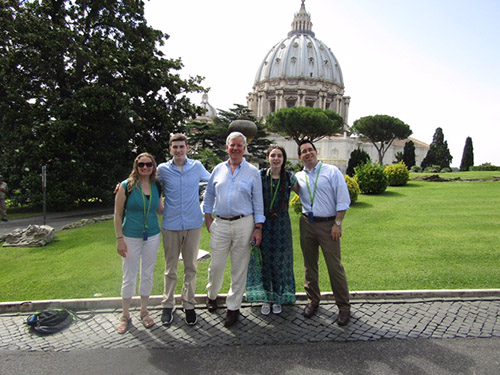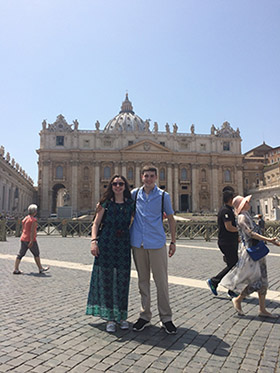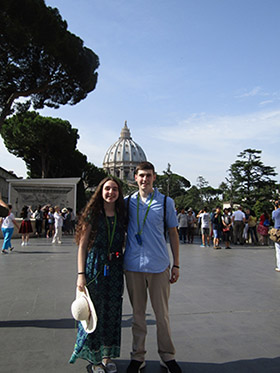> OUR PROJECTS > Students Learn Why It Is Important for the Blind to See Art in the Vatican Museums
STUDENTS LEARN WHY IT IS IMPORTANT FOR THE BLIND TO SEE ART IN THE VATICAN MUSEUMS
December 2016
article by Amy Gallant Sullivan, Dr. David A. Sullivan - essays by Patrick Harris & Angelina Kemmett - translations by Ludovica Mazzitelli
Thinking back to your formative years, do you recall one moment that shaped you and your perspective, a turning point, which was the catalyst of your growth from child to adult? How would you inspire and motivate young people to reach beyond themselves for knowledge and experience?
“I am truly blessed to go to Matignon High School, where such an 'experience' is possible.”
So said Angelina Kemmett, a sophomore at Matignon High School, who with Junior Patrick Harris, recently had a private guided tour through the Vatican Museums with a special focus on the multi-sensory exhibit for the visually impaired. Both students won an essay contest at Matignon, an independent and co-educational Catholic High School, in Cambridge, Massachusetts, addressing the question, “Why is it important for the visually impaired to “see” the art in the Vatican Museums?” Eight judges from around the world selected the two winners, with the award a trip with two chaperones to the Vatican Museums.
The idea for this contest originated with Dr. David A. Sullivan of Harvard Medical School and Schepens Eye Research Institute, who is a Matignon alumnus and a member of the Italian & International Patrons of the Arts of the Vatican Museums. The goals were to enrich the lives of students and help the Patrons develop relationships with Catholic Schools. The Italian & International Patrons, explained co-Founder Amy Gallant Sullivan, “are dedicated to the preservation and the perpetuation of arts, antiquities and sculptures in the Vatican Museums with a special focus on making art accessible to all, even those with disabilities (e.g. blindness) who otherwise would not be able to participate.”
“This trip was life-altering,” said Harris, “and I learned about how all people can “see” the awe-inspiring artwork in the Vatican Museums.” One of the chaperones, Susan Lenn Johnson, a Matignon theology teacher and campus Minister, stated, “I had never before considered the importance of accessibility of artwork for the visually impaired. I feel like this opened a whole new way for me to think of both artwork and our abilities. I can already recognize myself looking at accessibility to many things in our city differently too.”
“This was a once-in-a-lifetime trip,” said Christopher Martin, the other chaperone and Chief Advancement Officer at Matignon. And most importantly, said Sullivan, this initiative addressed the missions of both Matignon and the Italian & International Patrons: Matignon is committed to promoting academic excellence and student growth; and the International Patrons are dedicated to bringing together all individuals who have an appreciation for art, history and restoration.
Ms. Kemmett concluded, “Rome and Vatican City were absolutely amazing… but the most important part of the trip was that it brought me closer to my faith and taught me that my view of the world is not the only view there is. Art is sensational. It saves lives, and everyone should have the chance to experience it.”
Read the students’ winning essays and presentations:
> Presentation by Patrick Harris - Junior at Matignon
Good morning everyone. I’d like to begin by thanking Dr. Sullivan, Ms. Sullivan, and the Patrons of the Art in the Vatican Museums, without them an amazing opportunity like this would not have been possible.
I remember when I was younger and would go to museums, the first thing thing that was always said to me was, “don’t touch the art!” This never bothered me because I was still able to look at the artwork with my eyes and experience its beauty. It was not until our trip to the Vatican that I realized that people with visual impairment cannot experience art in the same way I do. Thanks to the hard work of the Patrons of the Arts, there are some exhibits specially designed for the visually impaired. As Angelina said, the 3D models of the artwork have extreme details that made me notice things with my hands, that I had not noticed with my eyes. I realized that I sometimes take my ability to see for granted. After this trip, I have learned to really appreciate my vision and all that I can do with it.
This was evident during one of the most memorable parts of our time at the Vatican. We had the unique opportunity to touch and explore a 3D replication of a relief from an ancient tomb, a piece that otherwise we would only be able to look at. It was really interesting to be allowed to experience the replication in a different way, not only with my eyes but with my touch. As the old artifacts deteriorate, so does the way they were once observed. What was so cool here, was that they weren’t just trying to restore these ancient artifacts, but they were recreating them so that one could touch and feel, truly explore the intricate details of it. This new way to experience the artwork is accessible to all people, visually impaired or not.
In addition to seeing the visually impaired exhibits, we also got to experience the celebration of mass at the Altar of St. Joseph in St. Peter’s basilica. Although the Mass was said in Italian, I felt as though I understood every word. Of course the content of the mass is the same as it is here in Boston, but it seemed even clearer listening to it and watching the priest go through the familiar motions in the basilica of Saint Peter. We also had the chance to explore so many other areas of the Vatican. One area that really had a strong impact on me was Saint Peter’s tomb. Beneath the main floor of the basilica in an area where many of the popes are buried. We saw tombs of popes from the early years of the church right up until the 20th century.
However, nothing compared to when we rounded a corner and saw the tomb of Saint Peter. Along with my dad, I stood there a long time just gazing at the small marble case enclosed by glass. It struck me that this was actually the bones of one of Jesus’ closest apostle, the first pope, and the man who Jesus called the rock. He was the one who was with Jesus in the garden when he was led away to be crucified, and denied him three times before the night was over. Yet he became pope, and I was looking at his final resting place. This made me realize that our faith is not just paintings or statues but an actual living thing. Saint Peter and so many others have sacrificed their lives for our faith. I realized that this experience was one of the highlights of the whole trip, and that a visually impaired person could not share the experience in the same way as me. The great work being sponsored by the Patrons has opened up so much for so many, and I know that someday it will lead to an experience of Saint Peter’s tomb so that any person could be as mesmerized as I was.
> Patrick's winning essay
> Presentation by Angelina Kemmett - Sophomore at Matignon
> Angelina's winning essay

.jpeg)


|